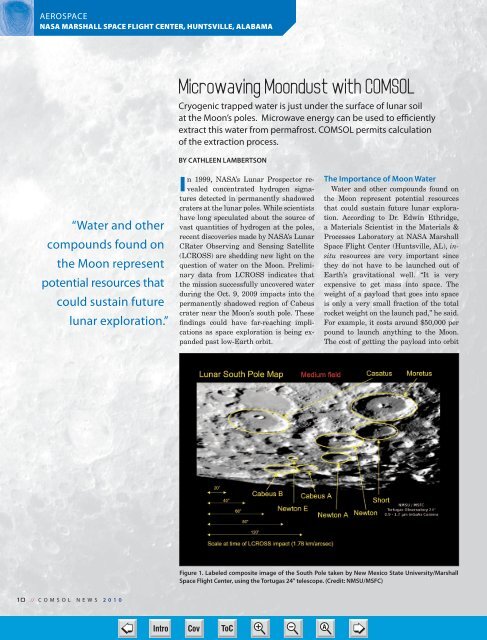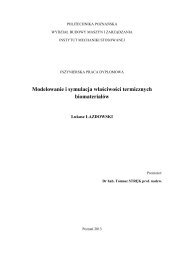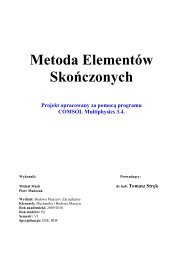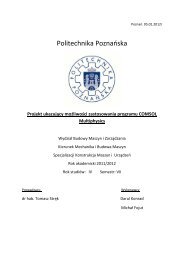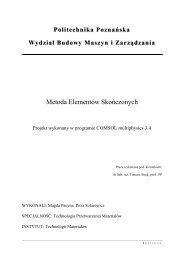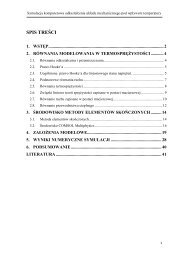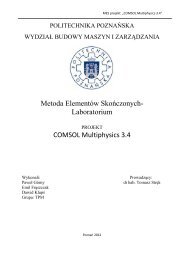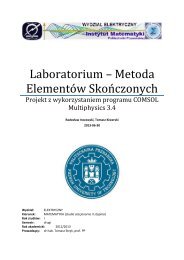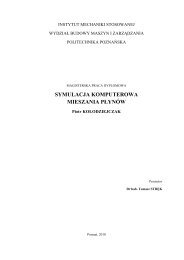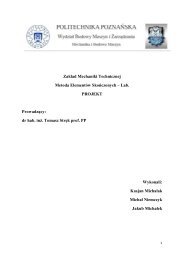comsol - tomasz strek home page
comsol - tomasz strek home page
comsol - tomasz strek home page
You also want an ePaper? Increase the reach of your titles
YUMPU automatically turns print PDFs into web optimized ePapers that Google loves.
AEROSPACE<br />
NASA MARSHALL SPACE FLIGHT CENTER, HUNTSVILLE, ALABAMA<br />
<br />
Cryogenic trapped water is just under the surface of lunar soil<br />
at the Moon’s poles. Microwave energy can be used to efficiently<br />
extract this water from permafrost. COMSOL permits calculation<br />
of the extraction process.<br />
“Water and other<br />
compounds found on<br />
the Moon represent<br />
potential resources that<br />
could sustain future<br />
lunar exploration.”<br />
BY CATHLEEN LAMBERTSON<br />
In 1999, NASA’s Lunar Prospector revealed<br />
concentrated hydrogen signatures<br />
detected in permanently shadowed<br />
craters at the lunar poles. While scientists<br />
have long speculated about the source of<br />
vast quantities of hydrogen at the poles,<br />
recent discoveries made by NASA’s Lunar<br />
CRater Observing and Sensing Satellite<br />
(LCROSS) are shedding new light on the<br />
question of water on the Moon. Preliminary<br />
data from LCROSS indicates that<br />
the mission successfully uncovered water<br />
during the Oct. 9, 2009 impacts into the<br />
permanently shadowed region of Cabeus<br />
crater near the Moon’s south pole. These<br />
findings could have far-reaching implications<br />
as space exploration is being expanded<br />
past low-Earth orbit.<br />
The Importance of Moon Water<br />
Water and other compounds found on<br />
the Moon represent potential resources<br />
that could sustain future lunar exploration.<br />
According to Dr. Edwin Ethridge,<br />
a Materials Scientist in the Materials &<br />
Processes Laboratory at NASA Marshall<br />
Space Flight Center (Huntsville, AL), insitu<br />
resources are very important since<br />
they do not have to be launched out of<br />
Earth’s gravitational well. “It is very<br />
expensive to get mass into space. The<br />
weight of a payload that goes into space<br />
is only a very small fraction of the total<br />
rocket weight on the launch pad,” he said.<br />
For example, it costs around $50,000 per<br />
pound to launch anything to the Moon.<br />
The cost of getting the payload into orbit<br />
Figure 1. Labeled composite image of the South Pole taken by New Mexico State University/Marshall<br />
Space Flight Center, using the Tortugas 24" telescope. (Credit: NMSU/MSFC)<br />
// COMSOL NEWS 2010<br />
➮<br />
Intro<br />
Cov ToC + – A<br />
➭


